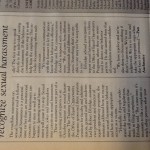Check it:
randomness muhahahahaha
Who’s Afraid of Black Sexuality? from the Chronicle of Higher Education
Once again, we are on the cutting edge with the scholarship we are engaging in class. Take a look:
http://chronicle.com/article/Whos-Afraid-of-Black/135960/
Enjoy.
Remember Their Names from Crunk Feminist Collective
In light of our discussion on narratives of resistance, I post this:
Rape
Cases of sexual violence have been reported since the 1980s, but preventive efforts have been taken at Emory since 1977. On November 1, 1977, Emory’s Student Government Association aims at rape prevention. The Student Government Association is an extremely influential group at Emory University. And to see them taking a stand on a major issue in the world really says a lot about Emory’s take on sexual violence. The student representatives in SGA are truly making an effort to prevent problems they might have seen on campus.
Two years later, on October 30, 1979, there is a rape seminar at Emory, which educates students about various prevention methods. The next month, University women are told how to deal with rape and learn how serious it can be and that no place is safe at all. What defines rape has been a confusing matter. “In a very short time we moved from a climate in which rape was widely regarded as rare to one in which rape is regarded as a widespread social problem” [1]. These changing occurrences of rape have been noted and Emory definitely tries to act upon thing and solve problems with various programs.
A couple years later, on October 6, 1981, a speaker comes to Emory who speaks of subliminal seduction. They dissect numerous ads for his audience as he projects each one on screen. This introduces new ways people can be sexual abused. Emory is really trying to take innovative approaches in dealing with sexual violence.
In that same year in 1981, Emory’s Training Center and Hospital Education Services co-sponsored an hour long self-defense program. They hope this program will change the national attitude toward crime from one of fear to one of rational assessment. Emory’s policy on sexual harassment states that all employees should be able to enjoy a work and educational environment that is free from all forms of discrimination, including sexual harassment.
Seminars continue at Emory University, which teaches students again how to recognize and deal with sexual harassment. There have even been plays have explore rape and had an enormous impact on viewers.
Wrapping it up…
‘Queerness, then, is not an identity, but a position or stance. We can use “queer” as a verb instead of a noun. Queer is not someone or something to be treated. Queer is something we can do. The black woman is the original Other, the figure against which white women’s sexuality is defined..to be silent is, yes, unexpected in a world of stereotype. However, silence merely stifles [us]. Silence does not change the status quo.’
– [1] Kimberly Springer, “Queering Black Female Heterosexuality”
It has been an exciting and insightful semester in From Archives to iPads: Investigating the Discourse on Sexuality at Emory. We have all exposed and engrossed ourselves in a world of sexuality. We have investigated Emory’s history as we leafed through old yearbooks and Emory Reports/Wheels. We have investigated sexuality in relationships, the sexual desires within us, sexually transmitted diseases, and sexual assault.
What we have done most this semester however, is talked. We have communicated our views and stands on sexually related issues and heard each other’s opinions about matters that affect us all. We have also learned how to keep silent. Silence is powerful- overriding communication, in my opinion. Our silence can denote our respect others opinions and our restraint to object however, this can also translate to our lack of concern. It can have detrimental effects, as we have seen with individuals failing to express their sexual preference, individuals failing to communicate medical conditions, and the inability to say ‘no’ and combat rape.
To finish off the semester, we have read an article by Kimberly Springer. In “Queering Black Female Heterosexuality,” she discusses the stereotypes of the black female and how pop culture views them- ‘hoes with silicone breasts and butts that jiggle and quake’. She also goes into great detail of the difficulties surrounding black women to profess their pleasures in sex without being viewed as “too fast” and a “jezebel” to society.
Public assumptions about black female sexuality cause insecurities within these woman and young women entering this group. ‘Perhaps, if we do not speak about black woman and sex, the whole issue will go away.’ Why can’t these women profess their sexual preferences and stand strong to their confessions without adopting negative stigmas by others?
This issue also can resonate with everyone and all communities. How easy is it to keep silent in these situations? Why has it become the norm for us as a society to create these stigmas of black females, heterosexuals, gay, and queer individuals? Why do we target black females as being sex icons?
Does this vision of black females victimize them sexually? When we think of rape and how it occurs, when one person fails to communicate and unwilling has sex, does this unwillingness to project themselves another form of sexual violence?
Silence and communication is essential to sexuality. What we fail is our ability to act one way or another. We should be able to profess openly about our sexual preferences and pleasures without receiving any negative push back from others; black females ultimately desire this. We should also learn how to tame ourselves and learn how to keep silent so that we can listen to each other’s needs and wants and prevent sexual assault. Silence will not change the status quo but it will defiantly feed it further unless we gather the courage to speak up and communicate our fight against sexual victimization and assault- it begins with NO!
[1] Springer, Kimberly. Yes Means Yes. Chapter 6: “Queering Black Female Heterosexuality” 77-91. California. Seal Press, 2008.
“I wasn’t raped but…” class discussion
I mean no disrespect to rape victims, but I feel that Gavey in “I wasn’t raped but…” used an incorrect analogy. We didn’t get a chance to discuss this in class, but I was curious how everyone else saw it.
Gavey paralleled rape to depression, suggesting that although one might say they’re not depressed, they can be if they have the symptoms. Similarly, some might say a person has been raped although the person does not identify as a rape victim.
Depression is in the DSM and a person must meet a couple of the requirements. Rape doesn’t have to meet requirements, its determined person to person. People interpret it differently so there isn’t a set definition- I see it similar to the definition of hookup (I think theblock wrote a blog on the definition of hookups). Some people might think rape is constituted by not giving consent while others believe the victim has to actively not give consent. It seems like there is a spectrum for the definition of rape to me.
Effects of Rape on Men
The article, “Effects of Rape on Men: A Descriptive Analysis” by Jayne Walker, John Archer, and Michelle Davies shows some significant differences between male and female rape victims in the UK. 852 reported male rape victims may seem very small in number, compared to 11,441 reported female rape victims (in 2002) (Walker et al. 495), but the public ignorance on the male victims may be causing different and possibly more pain in them individually.
Many of the male victims responded that they were shocked at the time of the assault by realizing how vulnerable they can be, probably being the major reason for 82.5% of the victims responding self-blaming for not being able to prevent the assault, 77.5% having low self esteem, and 68% feeling damaged with their masculinity (Walker et al. 501). The common stereotypes of men that expect them to be strong, active, and situation-handling seemed to be making the male victims suffer in different ways, compared to female victims, by making them to think that they failed to fulfill their expectations as men.
To me, it also seemed like an egg-and-chicken problem. Because of the lower number of reported rapes on men and the masculine stereotypes, people are generally much less aware of the issue. If a male becomes a rape victim, he is less likely to report or even just talk about his experience, because he cannot easily find a good place to start looking for help. The article also mentions that some “felt that their complaint was not taken seriously and [they] regretted their decision to tell the police” (Walker et al. 500).
Another interesting difference between male and female victims were questioning one’s sexual identity after being raped. Some formerly heterosexual male victims who experienced erection and ejaculation during the rape were confused with their sexuality because such bodily reactions were considered as enjoying. It is impossible to know how these male victims felt during and after the rape, but I thought they could also regard their erections as just a physiological response that are not different from having swollen face after being punched, or feeling tired after a sprint. Even Male babies are known to be capable of having erections when accidentally stimulated, but nobody would think that the babies were enjoying the accidental arousal.
Among the statistics, I was also surprised by the fact that 20% and 45% of the assaults happened at victim’s and perpetrator’s home, respectively (Walker et al. 497). As the article describes, this suggests that at least 65% of the victims could not imagine himself getting raped by their perpetrators. It actually reminded me of the “Project Unspoken: I am tired of the silence” clip by Respect Program. In the video, male and female students and staffs are being asked what they are doing in daily basis to prevent themselves from being sexually assaulted or harassed. Almost every male responded that they are not doing much in daily basis whereas all female participants could respond without much hesitation.
In order to provide greater help to male rape victims, we should become more knowledgeable about the issue. In order to do so, we would need more research on the victims and the nature of assaults, which will become possible when male-male rape becomes more acknowledged by the society as an issue.
Sources
Effects of Rape on Men: A Descriptive Analysis by Jayne Walker, John Archer, and Michelle Davies
Project Unspoken: I am tired of the silence by Emory University Respect Program (http://www.youtube.com/watch?v=eCCaKuWQLp8)
A different gender bias
If you Google ‘men raped by men,’ you will find that it’s not a particularly useful search. The top results report women raped by men, most of which describe events that are only distinctive because multiple men perpetrated each rape. After scrolling down, the next most frequent results represent a blend of assault definitions and survivor resources that encourage education and communication about male rape. In the first few pages of results, only two report a news story involving an identified man (or boy) whose assailants are being pursued.
Male rape is not a well-publicized topic. Only through our class have we been forced to acknowledge this issue. It is a representation of the kind of violence that women either avoid thinking about or don’t understand and most men want to ignore completely. For years the law and the press ignored the rape of men. Accusations went unpursued, victims were discredited, and rapists were free to continue their lives with no fear of retribution. The silence surrounding male rape prevented prosecution, but more importantly, it prevented victims from healing.
That silence could perhaps be attributed to the lack of occurrence in certain places. Although male rape likely occurs everywhere, it is in the areas in which its frequency is reportedly more prevalent where people have started to speak out against the violence (INCASA). It is also likely that the silence continues because of the fear of association with homosexuality. According to Tjaden and Thoennes, approximately 3% of American men have been raped in their lifetime. In comparison to the 17.6% of women, the number of men affected by rape is relatively smaller (Tjaden 7). However, ‘relatively smaller’ still equals approximately 2.78 million people so logically, there’s no reason for prevalence to be an excuse used to rationalize the lack of resources for male victims.
Walker, Archer and Davies report that, “the help and support for male victims of rape is more than 20 years behind that of female victims” (Walker 495). Although their study was focused on white British survivors, their findings support the hypothesis that there exists a gender bias in how society reacts and supports victims of sexual assault. Many of their participants claimed they were motivated to respond to the research proposal because they wanted to promote “informed publicity about male rape.” Many struggled to communicate with professionals who were not prepared to react to male victims in the same manner as they responded to females (Walker 500). Men have to worry more about being believed, because as one of last summer’s ASKMEN articles shows, many people don’t believe women can rape men. As a consequence, some men are left feeling emasculated. They are expected to be able to defend themselves and may develop self-blame as a result.
The authors of the British study found that the majority (90%) of the victims had faced some form of violence during the assault (Walker 497). Whether their current sexual orientation was gay, straight, bisexual or asexual at the time of the survey, none of the men involved wanted this to happen to them. They were left psychologically and often physically damaged in equal need of support and reassurance as their female counterparts.
Tjaden, Patricia and Nancy Thoennes. National Institute of Justice. Extent, Nature, and Consequences of Rape Victimization: Findings From the National Violence Against Women Survey. January 2006. https://www.ncjrs.gov/pdffiles1/nij/210346.pdf
Walker, Jayne, John Archer and Michelle Davies. Archives of Sexual Behavior. Effects of Rape on Men: A Descriptive Analysis. 2005
INCASA. Resources For Survivors. When Men Are Raped. 2011 http://www.incasa.org/advocacy/survivor-resources/when-men-are-raped/
Walsh, Wendy. ASKMEN.com. Men Raped By Women. Can A Man Be Raped? http://www.askmen.com/dating/love_tip_3800/3838_men-raped-by-women.html
sexual assaults on campus
The very first paragraph of Sexual Assault on Campus; A multilevel Integrative Approach to Party Rape states the saddest fact I have ever learned in college. “between one-fifth and one-quarter of women are victims of completed or attempted rape while in college.”(Armstrong480). As a man who absolutely loves women, and always insists on protecting, taking care of, and respecting them, this statistic haunts me. Why are our women living within a system that lets this happen?
The first fact I noticed to help me answer this question was one that I wrote about last week, alcohol and its correlation with sexual violence. Half way through the first paragraph Armstrong states, “At least half and perhaps as many as three-quarters of the sexual assaults that occur on college campuses involve alcohol consumption on the part of the victim, perpetrator, or both.” All through out life I never considered “party rape” to be rape. To me, rape was when a man or a woman, uses any type of force to have sexual relations with any individual against their will. I never considered being drunk the same as being forced against your will. But it is possible to be drunk enough to not be in control. Therefore, alcohol can be used to subdue a victim, just like physical force, a knife, or a gun. I always considered taking advantage of a girl who is too drunk to say no the lowest of all male actions. It is well known that alcohol takes away inhibitions, and sometimes leaves a girl defenseless. To my friends and I, man law states that if she is too drunk to know better than it is unacceptable, but as we all know, not all men live by such a chivalrous code. As the man if you are the drunkest person, you must be careful not to over step your bounds. Saying the wrong thing can have you walking home alone, and doing the wrong thing can have you in jail. If you’re both extremely drunk, then be extra careful. That’s the gray area, and suddenly two parties can both make mistakes. Regardless of who is how drunk, no means no, and real men should take a loss like a gentleman.
I have family and I would never want any of my younger female siblings to go through college having to worry about getting drunk and being taken advantage of. Armstrong repeatedly states that alcohol and environments with alcohol are key in setting up a situation where party rape can occur. It is listed that fraternity houses and bars are sexually threatening environments (Armstrong 481). This is a fact I agree with. Many times in most of theses places men will be looking to get girls into bed, and women will be looking to get attention from the men who are trying to take them home (Armstrong 483). Girls can even “earn scorn” form a male by wearing a “failed outfit” (Armstrong 483). . To me too much emphasis is put on sex, instead it should be put on partying without sexual implications. Often times college students feel as though they are supposed to go out and party (Armstrong,482,). Both boys and girls seek acceptance into their own groups and the cost of this acceptance can often be steep.
The second paragraph of page 483 states, “partying was also the primary way to meet men on campus…..people “don’t talk” in class. This could not describe Emory more. Class is long and stressful, when the weekend comes around all one wants to do is party and blow off some steam. Men try to get drunk and hook up, and girls do too. But some times men are willing to do too much to get too far.
Personally, I think party rape comes from two things. First, from the culture of “group acceptance” (Armstrong482). Men try to have sex to “fit in with their friends” and girls dress nice, get drunk, and go out to meet cute boys and girls :). Because these young girls think they need to dress to get attention, and get drunk to meet guys they are constantly in a dangerous position. Secondly, far too many men do not know when to stop, and do not have the fortitude to hold themselves to a higher standard of living. Far too many men would rather brag about taking advantage of a girl, than to enjoy the satisfaction of being a real man. A real man does not need alcohol; all he needs is a conversation.
Changing the culture of alcohol consumption will not stop sexual violence. But it will help decrease the rate of sexual assaults. There is not one way to stop sexual violence. To chop down a tree, the ax must be swung many times. By addressing alcohol abuse in our college culture, we can all take a huge swing against a society of rampant college sexual assaults.







